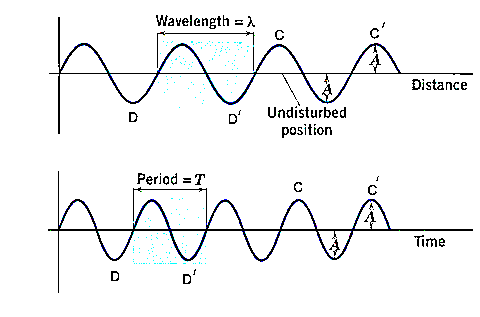
If equation of sound wave is $y = 0.0015\sin (62.4x + 316t)$ , then its wavelength will be
(A) 2 unit
(B) 0.3unit
(C) 0.1unit
(D) 0.2 unit
Answer
219.9k+ views
Hint: The given equation takes the exact form of the progressive wave equation$y = A\sin (\omega t - kx)$. So, on comparing both the wave functions, find out the value of the propagation constant k. k is related to the wavelength by $k = \dfrac{{2\pi }}{\lambda }$ . Now on substituting the values calculate the wavelength of the wave.
Complete step-by-step answer
A mathematical description of the disturbance created by a wave is called a wave function.

We know that, a progressive wave function is given by,
$y = A\sin (\omega t - kx)$
Where,
Y is the displacement; A is the amplitude; \[\omega \]is the angular frequency; x is the position; k is the propagation constant and t is the time.
$y = 0.0015\sin (62.4x + 316t)$
The given equation is similar to this wave function and therefore has corresponding values. On comparing with the progressive wave function we find out the value of the propagation constant also known as angular wave number.
$k = 62.8$
The number of wavelengths in the distance\[2\pi \]is called the wave number which is given by,
$k = \dfrac{{2\pi }}{\lambda }$
Substitute the value of the angular wave number.
$\lambda = \dfrac{{2 \times 3.14}}{{62.8}}$
$\lambda = 0.1unit$
Hence, the wavelength of the wave is 0.1 units and the correct option is C.
Note: If during the propagation of a progressive wave, the particles of the medium perform SHM about their mean position then the wave is known as a harmonic progressive wave. Various forms of progressive wave function.
$y = A\sin 2\pi \left( {\dfrac{t}{T} - \dfrac{x}{\lambda }} \right)$
$y = A\sin \dfrac{{2\pi }}{T}\left( {t - \dfrac{{xT}}{\lambda }} \right)$
$y = A\sin \dfrac{{2\pi }}{\lambda }\left( {vt - x} \right)$
$y = A\sin \omega \left( {t - \dfrac{x}{v}} \right)$
We can also write it in exponential form
$y = A\dfrac{{{e^{i\omega \left( {t - \dfrac{x}{v}} \right)}} - {e^{ - i\omega \left( {t - \dfrac{x}{v}} \right)}}}}{{2i}}$
Complete step-by-step answer
A mathematical description of the disturbance created by a wave is called a wave function.

We know that, a progressive wave function is given by,
$y = A\sin (\omega t - kx)$
Where,
Y is the displacement; A is the amplitude; \[\omega \]is the angular frequency; x is the position; k is the propagation constant and t is the time.
$y = 0.0015\sin (62.4x + 316t)$
The given equation is similar to this wave function and therefore has corresponding values. On comparing with the progressive wave function we find out the value of the propagation constant also known as angular wave number.
$k = 62.8$
The number of wavelengths in the distance\[2\pi \]is called the wave number which is given by,
$k = \dfrac{{2\pi }}{\lambda }$
Substitute the value of the angular wave number.
$\lambda = \dfrac{{2 \times 3.14}}{{62.8}}$
$\lambda = 0.1unit$
Hence, the wavelength of the wave is 0.1 units and the correct option is C.
Note: If during the propagation of a progressive wave, the particles of the medium perform SHM about their mean position then the wave is known as a harmonic progressive wave. Various forms of progressive wave function.
$y = A\sin 2\pi \left( {\dfrac{t}{T} - \dfrac{x}{\lambda }} \right)$
$y = A\sin \dfrac{{2\pi }}{T}\left( {t - \dfrac{{xT}}{\lambda }} \right)$
$y = A\sin \dfrac{{2\pi }}{\lambda }\left( {vt - x} \right)$
$y = A\sin \omega \left( {t - \dfrac{x}{v}} \right)$
We can also write it in exponential form
$y = A\dfrac{{{e^{i\omega \left( {t - \dfrac{x}{v}} \right)}} - {e^{ - i\omega \left( {t - \dfrac{x}{v}} \right)}}}}{{2i}}$
Recently Updated Pages
Electricity and Magnetism Explained: Key Concepts & Applications

JEE Energetics Important Concepts and Tips for Exam Preparation

JEE Isolation, Preparation and Properties of Non-metals Important Concepts and Tips for Exam Preparation

JEE Main 2021 July 25 Shift 1 Question Paper with Answer Key

JEE Main 2021 July 22 Shift 2 Question Paper with Answer Key

States of Matter Chapter For JEE Main Chemistry

Trending doubts
JEE Main 2026: Application Form Open, Exam Dates, Syllabus, Eligibility & Question Papers

Understanding Uniform Acceleration in Physics

Derivation of Equation of Trajectory Explained for Students

Hybridisation in Chemistry – Concept, Types & Applications

Understanding the Angle of Deviation in a Prism

How to Convert a Galvanometer into an Ammeter or Voltmeter

Other Pages
Thermodynamics Class 11 Physics Chapter 11 CBSE Notes - 2025-26

JEE Advanced Marks vs Ranks 2025: Understanding Category-wise Qualifying Marks and Previous Year Cut-offs

Units And Measurements Class 11 Physics Chapter 1 CBSE Notes - 2025-26

NCERT Solutions For Class 11 Physics Chapter 8 Mechanical Properties Of Solids

Motion in a Straight Line Class 11 Physics Chapter 2 CBSE Notes - 2025-26

NCERT Solutions for Class 11 Physics Chapter 7 Gravitation 2025-26




